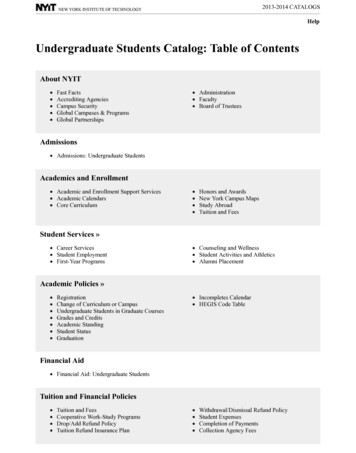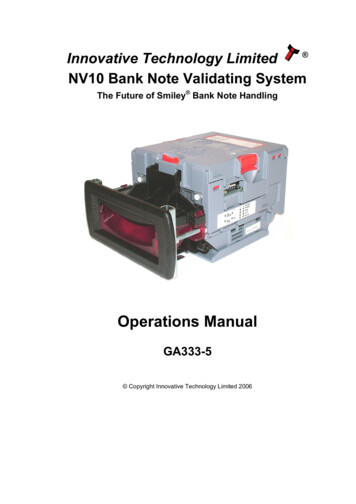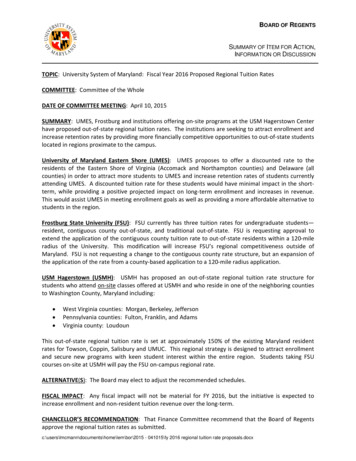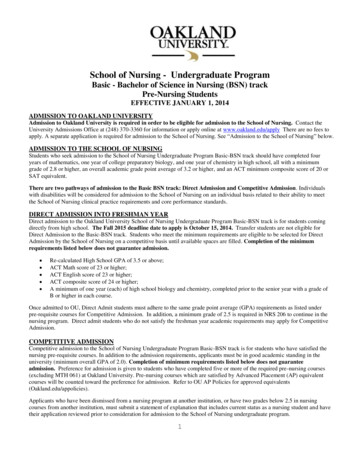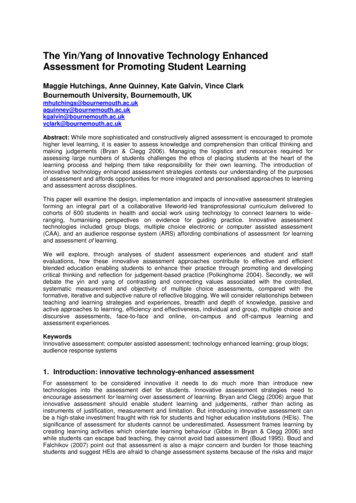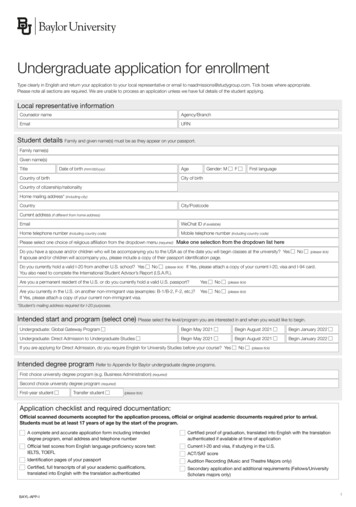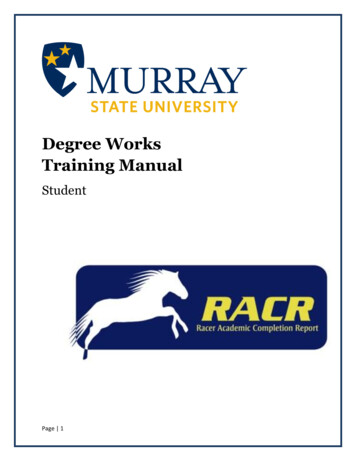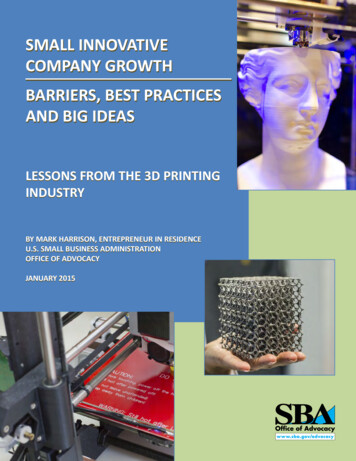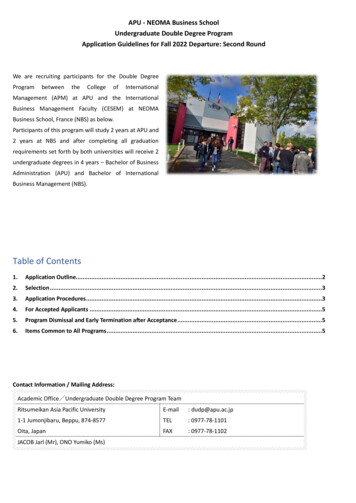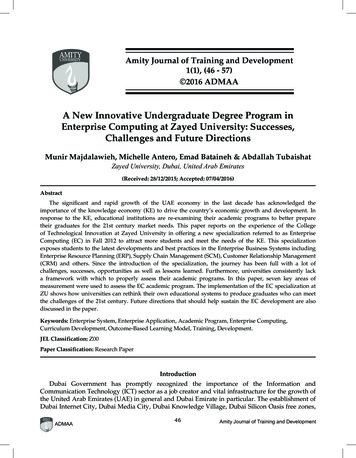
Transcription
AJTDVolume 1 Issue 1 2016Amity Journal of Training and Development1(1), (46 - 57) 2016 ADMAAA New Innovative Undergraduate Degree Program inEnterprise Computing at Zayed University: Successes,Challenges and Future DirectionsMunir Majdalawieh, Michelle Antero, Emad Bataineh & Abdallah TubaishatZayed University, Dubai, United Arab Emirates(Received: 28/12/2015; Accepted: 07/04/2016)AbstractThe significant and rapid growth of the UAE economy in the last decade has acknowledged theimportance of the knowledge economy (KE) to drive the country’s economic growth and development. Inresponse to the KE, educational institutions are re-examining their academic programs to better preparetheir graduates for the 21st century market needs. This paper reports on the experience of the Collegeof Technological Innovation at Zayed University in offering a new specialization referred to as EnterpriseComputing (EC) in Fall 2012 to attract more students and meet the needs of the KE. This specializationexposes students to the latest developments and best practices in the Enterprise Business Systems includingEnterprise Resource Planning (ERP), Supply Chain Management (SCM), Customer Relationship Management(CRM) and others. Since the introduction of the specialization, the journey has been full with a lot ofchallenges, successes, opportunities as well as lessons learned. Furthermore, universities consistently lacka framework with which to properly assess their academic programs. In this paper, seven key areas ofmeasurement were used to assess the EC academic program. The implementation of the EC specialization atZU shows how universities can rethink their own educational systems to produce graduates who can meetthe challenges of the 21st century. Future directions that should help sustain the EC development are alsodiscussed in the paper.Keywords: Enterprise System, Enterprise Application, Academic Program, Enterprise Computing,Curriculum Development, Outcome-Based Learning Model, Training, Development.JEL Classification: Z00Paper Classification: Research PaperIntroductionDubai Government has promptly recognized the importance of the Information andCommunication Technology (ICT) sector as a job creator and vital infrastructure for the growth ofthe United Arab Emirates (UAE) in general and Dubai Emirate in particular. The establishment ofDubai Internet City, Dubai Media City, Dubai Knowledge Village, Dubai Silicon Oasis free zones,ADMAA46Amity Journal of Training and Development
Volume 1 Issue 1 2016AJTDand the series of reforms and incentives support this recognition. To build upon these successstories, the Dubai Strategic Plan 2015 emphasizes the rapid increase of ICT in Dubai (DubaiStrategic Plan 2015, 2007). In the strategic plan, Dubai describes the aims targeting the knowledgebased economy (as cited by Gremm, Barth & Stock, 2015): “Preparing Dubai’s workforce for thehigh-value, knowledge-driven economy, which requires attracting and retaining highly skilledemployees, improving Nationals’ qualifications and increasing their motivation”. The plan is totrain and educate Emirates’ appropriately to build an ICT knowledge society with its four maincomponents: research, development, innovation and education.The significant and exponential growth of the UAE economy in the last decade has alsoacknowledged the importance of the knowledge economy (KE) as another source of revenue andeconomic growth. The concept of KE is based on the view that the ability to produce, distributeand use information and knowledge are essential for the economic growth and development(OECD , 2000). KE promises both opportunities and challenges. In such an environment,organizations expect fresh graduates with a different set of values, skills, knowledge andcompetencies. In response to the KE, educational institutions are re-examining their role,rethinking their standards & practices and accelerating curriculum reforms (Gardner, 1993) tobetter prepare their graduates for the workplace.Organizations are searching for IT graduates equipped with critical thinking and managerialskills to meet the rapid growth of the IT market in the UAE and the Gulf region as well. Theywould like graduates to be creative, innovative, and last but not least entrepreneurial. Hence, theIT market is looking at universities’ educational programs (or curricula) to produce knowledgeworkers capable of tackling the 21st century promises.Upon assessment of the needs of the current students, society, and market and future needsfor KE that may arise, the College of Technological Innovation (CTI) of Zayed University (ZU)launched the Enterprise Computing (EC) specialization in Fall 2012. Since then the journeyhas been full of challenges, success stories, as well as lessons learned. Through this paper,the present study discusses the experience in developing this cutting-edge specialization thatrevolves around enterprise business systems such as Enterprise Resource Planning (ERP),Supply Chain Management (SCM), Customer Relationship Management (CRM) and others. TheEC specialization is in line with one of ZU’s objectives which states “to establish a cutting-edgeeducational environment that promotes creativity and innovation’’ and one of the core valuesof ZU that “is to provide innovation through adoption and development of the highest globalpractices in teaching, learning and research”.According to Shan & Earle (1998) EC “involves the development, deployment andmaintenance of the information systems required for survival and success in today’s businessclimate”. The EC specialization at CTI was developed in response to the challenges that today’sorganizations face worldwide. Indeed, organizations are no longer confined into specific locationor time zone. Their functional areas are spread over different regions, even continents that workunder different legislations. The EC specialization aims at training students to apply IT knowledgeand skills in using enterprise applications to public and private organizations. It is designed toprepare the students for a broad range of careers that are focused on providing sound solutions toorganizations.The remainder of this paper is organized as follows. First, a brief description of ZU, CTI, andEC specialization is given. Then, the research gap and the contribution of the study are highlightedfollowed by a discussion on the research questions. Then, a discussion on the challenges that CTIfaced along with how such challenges were tackled and then the coverage of the key areas ofmeasurement of the EC program is discussed. Finally, recommendations, limitations of the studyand scope for future research are presented.Amity Journal of Training and Development47ADMAA
AJTDVolume 1 Issue 1 2016BackgroundZU is an academic federal government institution in the United Arab Emirates (UAE).It operates in two campus branches - one in Dubai and the other in Abu Dhabi. Currently, theUniversity is educating more than 9,000 male and female students. It has adopted an outcomebased learning framework to ensure that the student education is driven by specific outcomessuch as teamwork, critical thinking, and leadership. Moreover, the purpose of such a framework isto prepare graduates for a rapidly changing and unpredictable future. The University is accreditedby the Middle States Commission on Higher Education (MSCHE) in 2008 (Zayed University, 2015).CTI is one of the six colleges at ZU. It offers two main specializations in InformationTechnology: Security & Networking and Enterprise Computing. After assessing the needs of thestudents and the demands from the market, CTI put together a set of Information Technology andBusiness courses for the EC specialization as part of an 8-semester plan. The EC specializationwas endorsed by the CTI National Advisory Council and approved by the college curriculumcommittee, approved by the university curriculum committee, and was officially launched in Fall2012. The specialization adopts a series of hands-on labs and case studies from major enterpriseapplication vendors.Upon completing the degree course requirements, the students who sign up in thespecialization earn a Bachelor of Science in Information Technology Specialization in EnterpriseComputing (BSIT/EC). The BSIT/EC consists of 16 core IT courses (49 credit hour), 9specialization courses (27 credit hours), and 2-3 elective courses. This is in addition to one to twoyears of study in the general education program. Overall, the students are required to complete127 credit hours. In Spring2013, the first batch of 13 students graduated from the specialization inDubai.Research Gap and Contribution of the StudyThis study aims to fill the research gap in the academic and professional literature byinvestigating how Institutes of Higher Education (IHE) response to the urgent needs of preparingtheir students to be ready to join the workplace of the knowledge economy by continuouslyimproving their academic programs and introducing new ones. Introducing a new academicprogram is full of challenges and opportunities for all stakeholders to meet the Institute’s goalsand objectives.The primary purpose of this study is to answer the following questions: What are the challenges and opportunities that are associated with introducing new academicprogram? What are the key areas of measurement to be used to assess an academic program?This study makes a modest contribution to the academic and professional literature on thefactors and the corrective actions that need to be considered when introducing a new academicprogram. Furthermore, the study identifies and applies seven key areas of measurement to assessan academic program.DiscussionA growing number of academic and professional research papers and articles suggest thatlaunching new academic programs is time consuming, resource intensive and exhausted process.It requires in-depth proposal to answer questions like: Why is the program being proposed? Howwill it meet the institution’s goals outlined in the mission statement? How does it fit into theADMAA48Amity Journal of Training and Development
Volume 1 Issue 1 2016AJTDinstitution’s overall strategic plan? How will it be integrated in the current institution’s establishedprograms? Do returning students want or need the program? Does market research indicatesufficient demand in the region? How does the program meet the requirements of emergingknowledge based economy, or new trends in disciplines and professions? What kind accreditationis required for the program?Institutes of higher education recognize the effort of launching a new academic program, asthey have established policies, procedures, guidelines, and templates to help academic units tointroduce new programs in a more effective and efficient manner. The present study collectedmany data items about launching a new academic program by visiting many institutes of highereducation’s web portals and reviewing several academic and professional research papers andarticles (Ratcliff, 2004; Norman & Molly, 2011; Vassilakis, 2012; Slagle & Smith, 2009; Ali & Farag,2009; Lagos & Lainos, 2000). New academic programs can be successful when the ideas and allof the analysis flow from experienced faculty who will be involved in the development and thelaunching of the program. IHE carefully evaluated new proposals for introducing new programsto ensure the sustainability of the program since closing an academic program potentially hasserious impact on the institute, students, faculty, and community. There are many reasons formaking a decision to discontinue an academic program including: declining demand, not inline with the strategic plan of the institute, changes in the external national and internationalaccreditation requirements.Based on the above mentioned challenges of introducing a new academic program and aftercareful analysis of the data collected and intensive discussions among the authors of this article,the seven key areas of measurement emerged as essential to assess the EC academic program.Challenges and SuccessLaunching a new academic degree program is expected to go through various challenges andthe EC specialization at ZU is no exception. CTI encountered many challenges in developingBSIT/EC. During the first two years, the specialization suffered from low enrollment due tothe limited understanding of the words: enterprise and computing; inappropriate marketingstrategy; the dominance of some buzzwords like business careers and managerial positions; andmany students were unaware of or heard very little about the EC specialization. As such thespecialization was not considered by many students and enrollment was limited to only a singledigit number.The low enrollment concern was further compounded by the required minimum number ofstudents in a cohort so that a specialization remains active. As a result the EC was under closescrutiny putting more pressure on the college as well as the faculty teaching in the specialization.The limited understanding of the EC specialization also impacted the process of identifyinginternship opportunities for the students. Many found it difficult to articulate their degrees topotential employers in both public and private sectors.To address the aforementioned challenges a task force of faculty from both Dubai and AbuDhabi campuses was formed along with appointing a coordinator for the EC specialization.Different actions were taken place to market the specialization properly, to increase theenrollment, and improve the curriculum. Implementing the agreed-upon corrective actions wouldnot have been possible without the following factors:Amity Journal of Training and Development49ADMAA
AJTDVolume 1 Issue 1 2016 Full engagement of faculty in the specialization; Full support of the Dean of the college; Collaboration with some enterprise system vendors through seminars for the students,academic fieldtrips to some organizations using enterprise applications, etc.; Continuous review of the study plan; The appointment of a Program Coordinator; Investment in software and hardware resources to ensure proper delivery of course material; Partnership with an enterprise application vendor through its Academic Alliance Program hasgiven CTI access to a full range of online resources.These successes pose new management and academic challenges to sustain a successfulprogram. Many universities recognize their academic challenges, but few know the detailsof where their biggest challenges lie, to be able to assess their academic program to sustain asuccessful program.Key Areas of Measurement to Assess the EC Academic ProgramUniversities consistently lack a framework to properly assess their academic programs. Thepresent study used the following key areas of measurement to assess the EC academic program: Reference curriculum, Perception of the specialization Enrollment in the specialization Employment of the EC graduates Staffing the specialization IT and Facilities’ infrastructure Competitiveness of the specialization.Reference curriculumAt the early stages of offering a specialization on EC, a team of CTI faculty was formed.Unfortunately the lack of a commonly acknowledged reference curriculum for EC specializationhas led into an ad-hoc study-plan that could be used as a basis to start with. Such reference couldhave been a valuable core body of knowledge to ensure the program’s quality.The team developed the EC curriculum by: defining the objectives of the EC curriculum;choosing EC as the appropriate title; creating a list of courses that a student must complete (thiswas based on the knowledge of the team); developing the master syllabi for each course includingthe course description, teaching approach, assessment component for each course, establishing asystem of curriculum evaluation, and integrating people (soft), academic and professional skillsin the curriculum. By integrating these skills across the curriculum, the students will be giventhe opportunity to develop key skills as they progress through their degree requirements andprogram of study (de la Harpe, Radolf & Wyber, 2000). The structure of the EC specializationcurriculum is shown in Table 1.ADMAA50Amity Journal of Training and Development
Volume 1 Issue 1 2016AJTDTable 1: Required Courses in Enterprise Computing Specialization in ZUCourse #Course TitleCredit HoursCIT 261Enterprise and Information Systems Foundations3CIT 361Enterprise Systems3CIT 362IT in Logistics and Supply Chain3CIT 371Mobile Computing3CIT 372Cloud Computing3CIT 400Green Computing3CIT 463Enterprise Systems Developments3CIT 465Knowledge Management3CIT 492IT Infrastructure and Emerging Technologies3In 2013/2014 academic year, the EC specialization went through an in-depth assessment tocome up with recommendations to improve the specialization performance and to reflect on thenew KE needs. One of these recommendations was to restructure the study-plan in order to offerflexibility and depth of content. Students will have the flexibility to select two elective courses inaddition to the seven required courses. Two new courses were also introduced to provide in-depthcoverage that was initially missing from the curriculum. Moreover, CIT 492 “IT Infrastructureand Emerging Technologies” has been restructured to focus on “Emerging Technologies for theEnterprise”. The new program structure is shown in Table 2.Table 2: Revised Enterprise Computing SpecializationCourse #Course TitleCredit HoursCIT 261Enterprise and Information Systems Foundations3CIT 361Enterprise Systems3CIT 362IT in Logistics and Supply Chain3CIT 369Business Process Management3CIT 463Enterprise Systems Developments3CIT 468IT Strategy, Management, and Governance3CIT 492IT Emerging Technologies for the Enterprise3CIT xxxElective 1 (Selected Courses)3CIT xxxElective 2 (Selected Courses)3Perception of the specializationIn many ways, the specialization was perceived to be ahead of its time. ZU was one of thefirst universities in the region that sought out industry partners to deploy their applications forthe students to use. The university partners’ feedback has been positive and supportive. Soon,other universities followed suit and have considered offering a similar program. CTI faced somechallenges in launching the EC specialization and some of these were reflected in the students’perception of the major. Students’ perception of the learning environment (Trigwell & Prosser,1991 and Gijbels, Segers & Struyf, 2008) is one important factor of students’ learning mediation.Other factors include: approaches to learning (Prosser & Trigwell, 1999), and motivation andability to self-regulate learning (Zimmerman, Bandura & Martinez-Pons, 1992). Shrestha (2013)concluded that the public is concerned primarily with the trust, credibility, process, and theAmity Journal of Training and Development51ADMAA
AJTDVolume 1 Issue 1 2016output of any academic program. The perceptions of the ZU students’ learning environmentwere evaluated by conducting a survey. The survey was disseminated to some CTI students inDecember 2013, the students often choose their majors through word-of-mouth and by learningmore about the different majors on the Majors’ Day, a day where all colleges showcase theirmajors. Considering the EC specialization was new, the college had some difficulty in attractingenough students to sustain the specialization.Enrollment in the specializationCurrently the EC specialization is only available for female students. The student intake inthe EC program has steadily increased over a short period of time. There has been a significantincrease in the popularity of the EC specialization among pre-major students who are joiningthe college. Indeed they saw EC as a program that offers better job opportunities compared toother programs. This was demonstrated in a survey of students enrolled in the EC specializationwho were asked why they chose EC as their specialization. Half of the respondents mentionedavailability of potential job opportunities. About one third of the respondents indicated novelty ofthe EC specialization prompted them to choose EC. Around 26 percent indicated that their choiceswere influenced by their family. Finally, 23 per cent indicated that the potential jobs had attractivesalaries.The future plan is to make the program available to male students. This addition will help withfuture student recruitment and contribute to the long-term viability of the specialization. This will alsoopen the door for more Emiratis to join the private sector that is always looking for EC graduates.Employment of the EC graduatesDe la Harpe et al. (2000) suggest that “there is concern worldwide that existing undergraduateprograms are not producing graduates with appropriate life-long learning skills necessary fortheir careers” (Bandaranaike & Willison, 2015). The graduates’, in general, are receiving gooddegree specialization, but they also need to receive a variety of analytical, people and soft skillsto be able to handle complex information, analyze it and communicate it effectively. Warn &Tranter (2001) suggest that “graduate recruiters want a variety of other skills, personal andintellectual attributes, rather than specialist subject knowledge, oral communication, teamwork,self-management, problem solving, leadership” (Muhamad, 2012). Shrestha (2013) indicatedthat employability and practical skills followed by curriculum and faculty are the main factorsto enhance the reputation of an academic program. The EC specialization addresses graduates’concerns about job opportunities. Moreover, the increase in the intake can be attributed tothe success of the recent graduates who secured jobs in various sectors that rely on enterpriseapplications (e.g., ERP and SCM) in their daily operations. Some of CTI recent graduates havebeen offered jobs from their internship sites such as DEWA, ETISALAT, and Dubai Aluminum(DUBAL).One of the challenges that CTI/ZU and other federal academic institutions face is to motivateEmirati graduates to join the private sector. The public sector is almost “saturated”. The Emiratis“must be steered into private sector” is the title of an article in the Abu-Dhabi-based Nationalnewspaper shows that “the Emirati public sector employment market is reaching “saturationpoint” and the Government should focus on educational reform and the subsidization of privatesector wages”. The article further indicated that “the state can no longer act as an employer offirst and last resort and public sector jobs should not be part of the “social contract” by which theGovernment distributes oil wealth to its nationals”.ADMAA52Amity Journal of Training and Development
Volume 1 Issue 1 2016AJTDOne of the main causes of youth unemployment across the Middle East is the “experiencetrap” that leaves many university graduates unemployed after their graduation. Students in theregion often face both a “skills gap” and an “experience gap”. The “skills gap” is not having accessto the type of education necessary to acquire skills for a competitive positioning in today’s jobmarket, including pathways to employment or founding their own small businesses. Meanwhile,the “experience gap” arises where businesses, independent of size or industry, demand higherlevels of these essential skills along with experiences that students do not have. One of thestrength of the ECP is the partnership that CTI has with several leading IT companies includingSAP, IBM, CISCO, EMC, etc.IT and Facilities InfrastructureLaboratory-oriented courses in academic programs are essential to help students acquirethe skills and capability to be ready to join the very competitive market place. The views of theadvocates of laboratory-oriented courses expressed in statements such as “There is only little valueto the experiment if you do not perform it yourself, question it, or modify it in order to provideanswers to your queries” (Kingsley, 1890). The faculty of CTI recognized the importance of havinglaboratory-oriented courses and integrated these courses in the EC curriculum.ZU takes advantage of its state-of-the-art ICT infrastructure as well as modern campuses. Indeedthe campuses are fully networked and allow students to connect to various university networks andthe Internet from anywhere (e.g., classrooms, library, offices, student hubs, and cafeteria).At ZU, each student is required to purchase a laptop that will be loaded with softwarepackages through the university’s help desk to have easy access to technology needed tofacilitate the learning process and to complete their class work independently without having tobe on campus all the time. Also, each faculty member receives a laptop loaded with up-to-datesoftware packages to help in delivery the course content and communicate with students througha standard learning management system. In addition to the university’s main network, CTI hasan independent network infrastructure for teaching and research. All ZU courses are accessiblevia standard learning management systems that the students and faculty can access anywhere,anytime using a web portal.Being part of enterprise system vendor’ academic alliance program, CTI accesses the necessarysoftware that support labs. Three of the EC course offerings require that students access theseenterprise systems to give them the necessary hands-on skills that are sought by future employers.Particularly in CTI, the IT infrastructure has improved during the past few years. Since launchingthe EC program, several specialized lab facilities have been added to support the differentspecializations’ curricula and to provide space for the students to work on their projects.Staffing the specializationSince faculty and staff have a considerable influence on the overall success of any academicprogram, staffing the program is perhaps the single most important responsibility of theuniversity and college administrators represented by the Dean of the college. At the time oflaunching the program, the college had only two faculty in both campuses with InformationSystems background and one new hire with Enterprise and Industry experience. It was verydifficult to select, recruit and retain a team of faculty and staff members that have the neededskills, with appropriate knowledge and attitudes to support student learning in the EnterpriseComputing. This area is very unique and very few Ph.D. holders are specializing in this area.Moreover, some of the university alliances made with ES vendors required that faculty becertified in their software in order to teach some of the courses. This requirement put additionalpressure on the staffing requirement to either hire certified professionals or train the existingfaculty. The faculty has since been trained and certified by their vendor alliances to support theteaching activities of the college.Amity Journal of Training and Development53ADMAA
AJTDVolume 1 Issue 1 2016Competitiveness of the specializationTo be competitive, University should be able to add value to its academic programs byanticipating what society expects from its graduates (de la Harpe et al., 2000). University addsvalue by developing generic competencies in the program curriculum to prepare students forthe workplace and become adaptive and adaptable (Warn & Tranter, 2001). ZU is one of threefederal institutions in the UAE. The other two are Higher Colleges of Technology (HCT) and UAEUniversity (UAEU). HCT operates 16 campuses in six cities while UAEU operates in Al Ain. Theclosest program similar to CTI / EC specialization is offered by the UAEU Enterprise Systemsspecialization and HCT’s Business Solutions major.UAEU offers a Bachelor of Science degree in Information Technology (BSc in InformationTechnology) within seven specialization tracks. One of these tracks is Enterprise Systems(ENSYS), which is equivalent to ZU Enterprise Computing specialization. The structure of theENSYS’s curriculum is shown in Table 3.Table 3: Required Courses in the Enterprise Systems Track at UAEUCourse #Course TitleCredit HoursISBP301E-Enterprise3ISBP309Enterprise Information Systems3ISBP331Business Integration Lab I1ISBP350Enterprise Resource Planning3ISBP370System Analysis & Design3ISBP431Advanced Database Systems3ISBP432Advanced Database Systems Lab1ISBP433Business Integration Lab II1ISBP440Business Intelligence3ISBP455Knowledge Management3HCT offers a Bachelor of Applied Science in Information Systems: Business Solutions . BusinessSolutions major is equivalent to ZU Enterprise Computing specialization. The structure of theBusiness Solutions’ curriculum is shown in Table 4.Table 4: Required Courses in the Business Solutions Major at HCTCourse #Course TitleCredit HoursCIB 2003Technology Based Marketing3CIB 3003Human Resource Management and Systems3CIB 3103Object Oriented Analysis and Design3CIB 3203Accounting For Managers3CIB 3303E-Business Principles3CIB 3403Advanced Database Technologies3CIB 4003E-Business Applications Development3CIB 4103Business Finance3CIB 4203Customer Relationship Management Systems3CIS 2403Object Oriented Programming3ADMAA54Amity Journal of Training and Development
Volume 1 Issue 1 2016AJTDCurrently, there is no direct competition from these two federal institutions. At the sametime, the direct competition is from other majors in the CTI and the College of Business (CoB).Particularly, the Security and Network specialization in CTI and the Business and IT (MIS)specialization which are joint specialization courses between CTI and CoB.Recommendations, Limitations of the Study and Scope for Future ResearchThe implementation of the EC specialization at ZU shows how Universities can rethink theirown educational systems to produce graduates who can meet the challenges of the 21st century.The merits of the EC undergraduate degree are shown and the challenges that CTI faced whenthinking about, launching, and running the specializat
(CRM) and others. Since the introduction of the specialization, the journey has been full with a lot of . Dubai Media City, Dubai Knowledge Village, Dubai Silicon Oasis free zones, T 47 V 1 1 2016 AJTD ADMAA and the series of reforms and incentives support this recognition. To build upon these success

